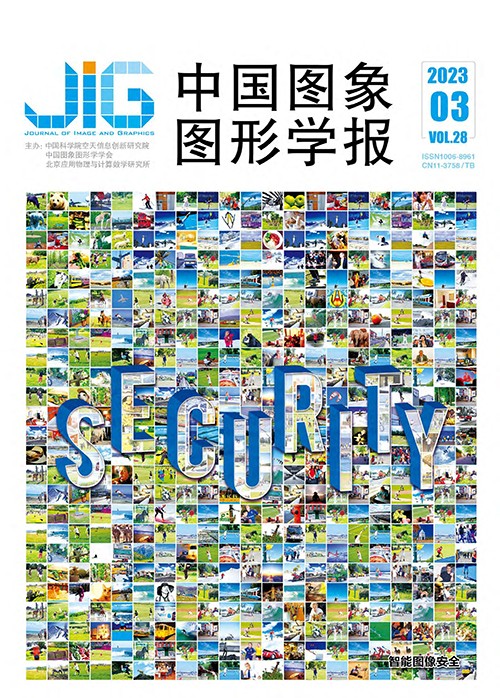
面向医学图像加密域大容量信息隐藏与认证方法
摘 要
目的 远程医疗诊断是通过将患者的医学图像、病历以及诊断结果等敏感信息分享给医生或医疗机构,达到远程辅助治疗的目的。然而,在医疗数据分享过程中,患者的敏感信息易受篡改或伪造,导致信息的保密性、完整性和隐私性受到威胁,严重影响医生对患者的诊断。针对以上问题,利用医学图像高冗余特性,本文提出一种加密域大容量信息隐藏与高效认证方案。方法 该方案结合半张量积压缩感知(semi-tensor product compressed sensing,STP-CS)与大容量秘密数据嵌入方式,将载体图像加密域腾出大容量空间用以嵌入患者信息。将医学图像数据分为非敏感数据和敏感数据两部分,通过传输非敏感数据以及STP-CS重构获取敏感数据实现云端与医院之间数据共享。结果 本方案可实现以低复杂度的重构方式将STP-CS重建图像恢复到高质量图像,并以高效率的认证方式验证载体图像及嵌入秘密信息的完整性。为了验证算法的有效性,与优秀的图像恢复算法在不同部位MRI(megnetic resonace imaging)图像进行测试评估。实验结果表明,本文算法得到的载密图像能腾出约3.75 bit/像素的空间嵌入秘密信息,峰值信噪比均优于对比方法,相比于性能第2的方法提高了约810 dB。此外,本文算法恢复医学图像同样优于对比方法,有潜力应用于实际的远程医疗诊断。结论 本文方法不仅提高数据的机密性,而且可获得现有医学图像共享方案中不具备的新功能,包括逐步恢复、像素压缩和大容量秘密信息嵌入等。
关键词
Large-capacity data hiding and authentication method in encryted domain for medical image
Wen Wenying1, Zou Menglei1, Fang Yuming1, Zhang Yushu2, Zuo Yifan1(1.School of Information Management, Jiangxi University of Finance and Economics, Nanchang 330013, China;2.College of Computer Science and Technology, Nanjing University of Aeronautics and Astronautics, Nanjing 211106, China) Abstract
Objective Telemedicine diagnosis has become one of heath seeking behaviours in big data era. To make a quick responsed accurate diagnosis, telemedicine diagnosis can used for the sharing of sensitive information to doctors or medical institutions in terms of a large amount of sensitive information of patients like patient identity information, medical profiles and medical-relevant images. The medical sensitive information security is required for transmiting. However, patients’ sensitive information is vulnerable to be tampered or forged in the process of medical data sharing, which affects doctors’ diagnosis of patients due to the threatens of the confidentiality, integrity and privacy of information. Therefore, telemedicine diagnosis is challenged to information preservation and the integrity of medical data. Method To resolve the problems mentioned above, we develop a cryptographic domain high-capacity information hiding scheme. To leak out about 3.75 bit/pixel of space in the encrypted domain of carrier images for embedding patient sensitive information, the scheme is coordinated semi-tensor product compressed sensing (STP-CS)-integrated to high-capacity secret data embedding method. A low-order Gaussian chaotic matrix is constructed to compress and sample medical images with a semi-tensor product, whereas the storage space of the measurement matrix can be reduced exponentially and the real-time reconstruction at the receiving end can be improved as well. Residual value prediction is uitilized to provide data embedding space, and the processes of data extraction and image restoration are splitted. Specifically, the medical image data is segmented into two categories: 1) sensitive data and 2) non-sensitive in terms of the prediction residual matrix. At the receiving end, medical image information is initially recovered via sensitive data-reconstructed, and the residual matrix-based medical images are then recovered to reconstruction capability-optimized image sharing scheme. The data is split at the receiving end, and partial data is used for STP-CS reconstruction to recover sensitive data for pre-reconstructed medical images. The data remaining is employed to extract confidential patient information and non-sensitive data, which allows that the pre-reconstructed medical images to be recovered. Considering that the attacker may tamper with the image data in the image data transmission, the data integrity authentication step is added to the image data, which can accurately complete the authentication under the interference of quantization noise and transmission noise. However, the tampered image data is still challenged to be authenticated. Result This scheme can achieve the recovery of STP-CS-reconstructed images to high-quality images with low-complexity reconstruction, and verify the integrity of carrier images and embedded secret information with high-efficiency authentication. STP-CS not only optimizes the storage space of the measurement matrix by multiple, but also improves the real-time performance of reconstruction. To verify the effectiveness of our scheme proposed, we select 4 MRI (megnetic resonace imaging images) targeted on different parts of the human body, and our scheme is then evaluated with 3 kind of popular image recovery algorithms on these images. The experimental results show that the peak signal-to-noise ratio (PSNR) of this algorithm is optimized further, and the performance of this algorithm is improved and valued by about 810 dB compared to the second method. To analyze the security of the proposed algorithm, we introduce 3 sort of measurement methods like 1) key space, 2) histogram, and 3) entropy. Experimental results demonstrate that the key space of this scheme is 1016×1016×1024×1024= 1080≈ 2240 (≫ 2100), which is sufficient to prevent brute force attacks. The histograms of the encrypted image and the image are flat and cosistent with non-embedded secret information, which verifies the proposed scheme is enough to prevent attackers from obtaining histogram-based valuable information. Additionally, the entropy of all encrypted images is close to the benched value of 8, and thus the proposed scheme has the ability to resist entropy cryptanalysis. To analyze its robustness, 1) cropping acctack, 2) JPEG (joint photographic experts group compression), and 3) noise interference are selected, and the experimental results show that the interference against both of cropping and noise attacks have good robustness there, and the bit error rate (BER) of secret information is less than 5%, which ensures the integrity of secret information. To validate the effectiveness of the algorithm, the experiments demonstrate the reconstruction quality of medical images at different scale of resolutions, and the experimental results show that higher resolution is beneficial to image reconstruction quality. The size of the half-tensor measurement matrix can be matched to the optimization of image accuracy, the change of resolution does not enforce the degradation of the reconstruction quality of the images, as well as the embedding of secret information is guranteed. Conclusion Our scheme can optimize data confidentiality and provide new features in relevant to step-by-step recovery, pixel compression, and high-capacity secret information embedding.
Keywords
medical image high-capacity reversible hiding semi-tensor product compressed sensing (STP-CS) security authentication progressive reconstruction
|



 中国图象图形学报 │ 京ICP备05080539号-4 │ 本系统由
中国图象图形学报 │ 京ICP备05080539号-4 │ 本系统由